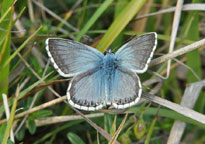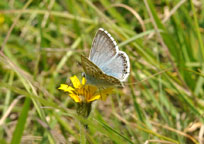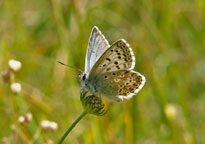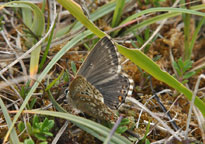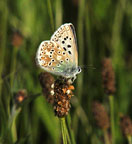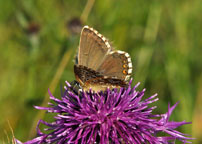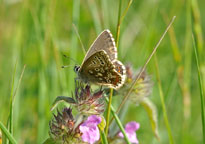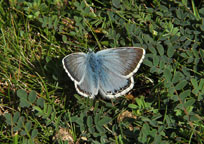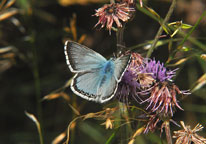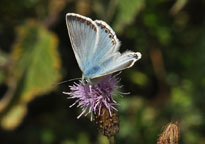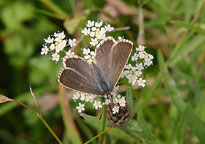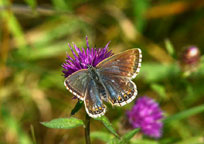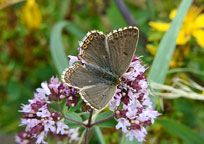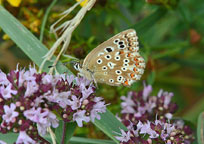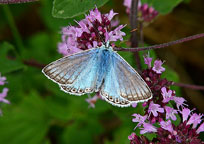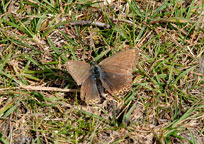The Chalkhill Blue, Polyommatus coridon
The Chalkhill Blue is limited to chalky areas where its food plant, Horseshoe Vetch, grows. My nearest substantial colony is on the Devil's Dyke on Newmarket
Heath. There is a smaller colony at Fleam Dyke.
There is one brood per year with the adults in flight in July and August.
2011 had a hot dry spring, most butterflies were in flight about two weeks early. This year I saw about 8 on July 3rd. On July 15th there were several hundred
dancing all over the south-facing bank opposite to the July Course stands on Newmarket Heath. They were active in a bright period in the middle of a warm,
breezy day with alternating sunshine and cloud.
It looked as if there was about one female in flight for every 50 males.
On 3 Sept 2011 I saw 7 at Fleam Dyke and 20-30 at Devil's Dyke, and all looking very worn. I saw no blue males, just brown females and one that appears to be a
a blue winged female (at Fleam Dyke).
Reference: Mike Gittos, Cambridgeshire and Essex Branch Newsletter, 55: 15-23 (Feb 2008). Detailed account of of the Devil's Dyke colony and its
conservation. Also speculation on the possibilty that the current colony is descended from a re-introduction which may have wholly or partly replaced the
previous population.
2013 stray butterflies in Essex. The Cambridgeshire and Essex Branch Newsletter of October 2013 reported several male Chalkhill Blues in areas away from
their normal breeding grounds. Reports were from Langdon Reserve, some meadows near Hanningfield Reservoir and from Bedford's Park, Romford in Essex.
It was thought likely that on hot summers a few individual disperse from their main colonies.
Distinguished from similar looking butterflies:
Male upperside:
differs from Common Blue by its paler shade of blue (not so different from a worn Common Blue), by its broader gray/black edging and its more distinct,
though feint, spotting near the edges. Continuation of dark lines across the white borders.
Brown female upperside:
differs from brown female Common Blue by continuation of dark lines across the white borders.
differs from Brown Argus by continuation of dark lines across the white borders and by the much less bright orange fore-wing spots.
Almost impossible to distinguish from Adonis Blue. Small marks next to wing circles may be white rather than blueish if present. The thin black discoidal line
seems to be more likely to have a white surround in this species.
Blue female upperside:
differs from male Chalkhill Blues (usually) by a small discoidal mark.
differs from both male Common Blues and Holly Blues by the dark spots with paler surrounds along the fore-wing outer margins.
Male underside:
differs from Common Blue by continuation of dark lines across the white borders.
differs from Brown Argus by continuation of dark lines across the white borders, by lack of orange spots on the forewings
and by spots between the middle and the base of the forewing.
Female underside:
differs from Common Blue by continuation of dark lines across the white borders.
differs from Brown Argus by continuation of dark lines across the white borders, by weaker, if any, orange spots on the forewings
and by spots between the middle and the base of the forewing.
Personal sightings:
Devils Dyke.
3 July 2011. Newmarket Heath. 6 Chalkhill Blues.
15 July 2011. Newmarket Heath. Many Chalkhill Blues.
31 July 2011. Reach end. Early to mid afternoon, bright intervals, windy. Many Chalkhill Blues.
7 Aug 2011. Essex and Cambs Branch field walk. Fairly bright, windy. Newmarket Heath, c. 30 Chalkhill Blues; Golf Course end, c. 10 Chalkhill Blues.
3 Sept 2011. Sunny, windy. Newmarket Heath. 20-30 Chalkhill Blues all very worn - none were seen to be male.
15 Sept 2012. TL614618. Newmarket Heath. 7 Chalkhill Blues.
15 Sept 2012. TL5765. In and near Burwell Railway cutting. 5 Chalkhill Blues.
Fleam Dyke.
23 July 2011. East side. Mid to late morning, bright intervals, windy. 5 Chalkhill Blues.
3 Sept 2011. East side. Sunny, windy. c. 7 Chalkhill Blues, all very worn, none appearded to be male.
12 Aug 2012. Between A11 and Bedford Gap. c.180 Chalkhill Blues. Note: counted just before 10.00 am, as it got warmer there seemed to be about twice as
many CHBs walking back, but not recounted.
13 Sept 2012. East side. Mid day, bright but breezy. 2 Chalkhill blues, 1 male, very worn, 1 female.
Therfield Heath.
22 July 2012. Therfield Heath. Walking east from the top west corner of the hills.
Western corner with the wood behind and to the south. Thin, poor grass. 17 Chalkhill Blues.
The bank close to and north of the road to Therfield. Longer grass. 6 Chalkhill Blues (5 male, 1 female).
Along the ridge nearest to and south of the road. 11 Chalkhill Blues.
From the second gully south of the road to the 3 small tumuli on top of the down. 9 Chalkhill Blues
(2 female, 7 male). The Chalkhill Blues gradualy thinned out as the grass got stronger towards the 3 mounds.
26 July 2012. Walking east near the top of the hills from the road which crosses the heath to the eastern end. There were very many Chalkhill Blues in the
upper parts of the heath to the eastern end. Once past the tumuli the numbers of Chalkhill Blues inceased to a similar if not greater density as further west.
There were far too many to count, except possibly by extrapolation from random sample quadrants.
Aston Rowant, Oxfordshire.
26 Aug 2012. North of M40: about 15 Chalkhill Blues, fairly worn to very worn. South of M40: 1 Chalkhill Blue.
